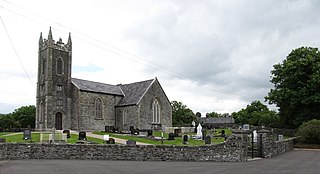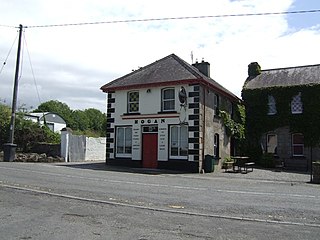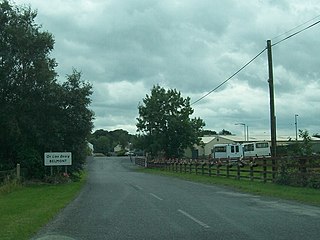
Ballymahon on the River Inny is a town in the southern part of County Longford, Ireland. It is 19 km north-east of Athlone, at the junction of the N55 and R392 roads.

Castlepollard is a village in north County Westmeath, Republic of Ireland. It lies west of Lough Lene and northeast of Lough Derravaragh and Mullingar.

Kanturk is a town in the north west of County Cork, Ireland. It is situated at the confluence of the Allua (Allow) and Dallow (Dalua) rivers, which stream further on as tributaries to the River Blackwater. It is about 50 kilometres from Cork and Limerick, and lies just north of the main N72 road, 15 km from Mallow and about 40 km from Killarney. Kanturk is within the Cork North-West Dáil constituency.

Stradone is a village located in County Cavan, Ireland. It is situated in the civil parish of Larah six miles from Cavan, near the N3 road between Cavan and Virginia. Stradone is classified as a 'small village' in the Cavan County Council Development Plan 2014-2020.

Clohamon is a small, rural village and townland near Bunclody in County Wexford, Ireland. Located on the River Slaney, Clonmahon's bridge dates to the late 18th or early 19th century. Previously the site of a large mill, there is now a meat processing factory in Clohamon.

Rhode is a village in County Offaly, Ireland. It is situated on the R400 at its junction with the R441 which leads to Edenderry, 12 km to the east. Rhode village is on an "island" of high ground surrounded by an expanse of raised bog which forms part of the Bog of Allen.

Ballitore is a village in County Kildare, Ireland, sometimes spelt as Ballytore. It is noted for its historical Quaker associations. It was the first planned Quaker village in either England or Ireland - and remains the only one in Europe.

Street or Streete is a village and parish in County Westmeath, Ireland. It lies on the regional road between Lismacaffery and Rathowen. Its Irish name was historically anglicised as Straid or Strade.

Brosna is a small village and townland in County Offaly, Ireland. 7 km north-west of Roscrea, it lies in the valley of the Little Brosna River near the N62 road. The area takes its name from the Little Brosna River, which flows along the north-eastern edge of the townland. As of the 2011 census, Brosna townland had a population of 31 people.

Knockbride is a civil parish in County Cavan, Ireland. It is located to the north of the town of Bailieborough.
Portland is a townland in the barony of Ormond Lower, County Tipperary in Ireland. It is located north-east of the Portumna bridge, in the civil parish of Lorrha.
Derrinsallow is a townland in the historical Barony of Ormond Lower, County Tipperary, Ireland. It is located North-West of Birr on the south-west bank of the Little Brosna River within the civil parish of Dorrha. The Little Brosna River provided power to the 19th century corn mills at Derrinsallow which although now in ruins are mentioned in the National Inventory of Architectural Heritage. The mill race is a popular fishing area. A triple arched limestone bridge from the 19th century crosses the river here.

Ballinderry is a village and a townland in the historical Barony of Ormond Lower, County Tipperary, Ireland. It is located between Terryglass and Nenagh where the R493 road crosses the Ballyfinboy River.
Clonahenoge is a townland in County Offaly, Ireland. It is located at the confluence of the Little Brosna River and the River Shannon.
Ollatrim is a townland in the historical Barony of Ormond Upper, County Tipperary, Ireland. It is located in north Tipperary between the settlements of Toomevara and Moneygall. The Ollatrim River flows through Ollatrim and the R445 road passes over the river within the townland.
Castletown Cox, or Castletown House, is a restored Palladian mansion and demesne located in County Kilkenny, Ireland.

Belmont is a village in County Offaly, Ireland.

Hawkswood is a townland in the civil parish of Kinawley, Barony of Tullyhaw, County Cavan, Ireland. The original Irish place name was Cluain Caomh meaning 'The Beautiful Meadow'. The town of Swanlinbar is partially situated in Hawkswood. According to the 1938 Dúchas collection two sub-divisions are- The Cleity - A name given to a field in a farm owned by Mr. Patrick Maguire, Hawkswood, Swanlinbar, Co. Cavan. The Rhythars - a name given to a field in a farm owned by Mr Hugh McBrien, Hawkswood, Swanlinbar.

Loughtee Lower, or Lower Loughtee, is a barony in County Cavan, Ireland. Baronies were mainly cadastral rather than administrative units. They acquired modest local taxation and spending functions in the 19th century before being superseded by the Local Government (Ireland) Act 1898.

Ardue is a townland in the civil parish of Drumlane, Barony of Loughtee Lower, County Cavan, Ireland.

















